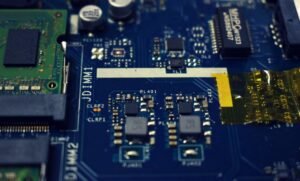Language Processing after Brain Injury
Language processing refers to the way our brains interpret and understand spoken and written language. After experiencing a brain injury, such as a stroke or trauma, individuals may encounter difficulties with their language abilities. However, with proper assessment, therapy, and support, many people can regain some or all of their language skills.
Key Takeaways:
- Brain injuries can impact language processing abilities.
- Proper assessment and therapy can help individuals regain language skills.
- Support from professionals and loved ones is crucial in the rehabilitation process.
Brain injuries can have various effects on an individual’s ability to process language. Some common issues include difficulty with speech production, understanding spoken and written words, and expressing thoughts and ideas clearly. *Language therapy can significantly improve an individual’s language processing abilities by targeting specific areas of difficulty.*
It’s important to note that there are different types of language processing disorders that can occur after a brain injury. For example, aphasia is a condition that affects a person’s ability to understand and use language. Apraxia, on the other hand, is a disorder that affects the ability to coordinate the movements necessary for speech. **Each individual’s experience and needs may vary**.
Language Processing Disorders
Table 1: Types of Language Processing Disorders
| Type of Disorder | Description |
|---|---|
| Aphasia | Affects comprehension and expression of language. |
| Apraxia | Difficulty coordinating the movements required for speech. |
| Dysarthria | Weakened or uncoordinated muscles needed for speech. |
Individuals with language processing disorders may benefit from a combination of therapy methods. **For example, some techniques focus on improving comprehension, while others work on improving speech production**. Additionally, alternative communication methods, such as the use of assistive technology or sign language, may be helpful for individuals with severe language difficulties.
Table 2: Therapy Methods for Language Processing Disorders
| Therapy Method | Description |
|---|---|
| Speech and Language Therapy | Targeting specific language skills and areas of difficulty. |
| Cognitive-Communication Therapy | Improving language and cognitive skills. |
| Alternative and Augmentative Communication | Using alternative methods to support communication, such as speech-generating devices. |
Support from professionals, such as speech-language pathologists, as well as family and friends, plays a crucial role in the rehabilitation process. **Recovery from a language processing disorder can be a unique and ongoing journey**. Patience, understanding, and a supportive environment are essential for individuals with brain injuries to regain their language skills and adjust to any changes that may have occurred.
Table 3: Tips for Supporting Individuals with Language Processing Disorders
- Encourage effective communication strategies, such as using visuals or written cues.
- Provide opportunities for practice and repetition in a supportive environment.
- Seek professional guidance and therapy for targeted intervention.
- Offer emotional support and understanding throughout the recovery process.
In conclusion, language processing after a brain injury can be challenging, but it is not impossible to regain and improve language skills. Through appropriate assessment, tailored therapy, and a supportive network, individuals can work towards overcoming the obstacles they may face. **With determination and the right resources, individuals with language processing difficulties can make significant progress in their recovery journey**.

Common Misconceptions
Language Processing after Brain Injury
There are several common misconceptions that people have about language processing after a brain injury. These misconceptions can often lead to misunderstandings and incorrect assumptions about individuals who have experienced such injuries.
- People with language processing difficulties after a brain injury always have trouble speaking.
- Language processing difficulties are permanent and cannot be improved.
- Language processing difficulties only affect verbal communication.
One common misconception is that individuals with language processing difficulties after a brain injury always have trouble speaking. While it is true that speech difficulties can occur, it is important to recognize that language processing encompasses more than just speaking. It also includes understanding and processing written language. For some individuals, their ability to understand and process written language may be more impaired than their ability to speak.
- Language processing difficulties can also affect reading comprehension and writing skills.
- The severity of language processing difficulties can vary greatly among individuals.
- With therapy and appropriate interventions, language processing difficulties can improve over time.
Another misconception is that language processing difficulties after brain injury are permanent and cannot be improved. While it is true that some individuals may experience long-term difficulties, there is evidence to suggest that with therapy and appropriate interventions, language processing skills can improve over time. Rehabilitation programs focused on language and speech therapy can help individuals regain and strengthen their language skills.
- Individuals with language processing difficulties may have intact intelligence and cognitive abilities.
- It is important to provide support and accommodations for individuals with language processing difficulties.
- Education and awareness can help reduce misconceptions and promote understanding of language processing after brain injury.
A misconception that often arises is that individuals with language processing difficulties after a brain injury have overall cognitive impairments. However, it is crucial to recognize that intelligence and cognitive abilities can remain intact even if language processing is affected. These individuals may face challenges in expressing themselves and understanding others, but they can still possess the ability to reason, problem-solve, and engage in complex thinking.
In conclusion, it is important to dispel common misconceptions about language processing after a brain injury. Understanding that language processing difficulties can manifest in various ways and that they are not necessarily permanent can help in providing appropriate support and interventions for affected individuals. By promoting education and awareness about these misconceptions, we can foster a more inclusive society that supports the needs and rights of those living with language processing difficulties after brain injury.

Factors that Affect Language Processing after Brain Injury
Language processing can be significantly impaired after a brain injury, affecting an individual’s ability to understand and communicate effectively. Several factors have been identified that can influence language processing outcomes post-injury. The following table presents key factors and their impact on language processing.
| Factor | Impact on Language Processing |
|---|---|
| Location of Injury | Different areas of the brain control different aspects of language processing. The specific location of the injury can determine the specific language impairments experienced. |
| Severity of Injury | A more severe brain injury typically results in more profound language processing difficulties. |
| Age at Injury | Brain injuries occurring earlier in life can have a more significant impact on language development and long-term language processing abilities. |
| Time Since Injury | The duration since the brain injury can affect the progress of language recovery. Early intervention and therapy yield better outcomes. |
| Cognitive Skills | Pre-existing cognitive skills, such as attention, memory, and problem-solving, influence language processing abilities after brain injury. |
| Emotional State | Emotional stress and psychological factors post-injury can impact an individual’s ability to concentrate on language tasks and affect communication. |
| Speech Therapy | The frequency, intensity, and quality of speech therapy received can significantly improve language processing outcomes. |
| Supportive Environment | An environment that fosters understanding, patience, and provides appropriate accommodations positively influences language processing recovery. |
| Individual Motivation | An individual’s motivation, engagement, and active participation in language rehabilitation activities can enhance language processing improvement. |
| Social Support | A strong social support system and positive interactions with family, friends, and professionals can positively impact language processing and overall recovery. |
Common Language Impairments after Brain Injury
Brain injuries can lead to various language impairments that make it challenging for individuals to communicate effectively. The table below outlines some common language deficits observed in individuals after experiencing a brain injury.
| Language Impairment | Description |
|---|---|
| Aphasia | Aphasia refers to the loss or impairment of language abilities, including difficulties with speaking, comprehension, reading, and writing. |
| Dysarthria | Dysarthria is a motor speech disorder that affects the muscles used for speech production, resulting in slurred or unclear speech. |
| Apraxia of Speech | Apraxia of speech is a neurological disorder characterized by difficulty planning and coordinating the precise movements of speech muscles. |
| Reading Comprehension Deficits | Difficulties in understanding written text and extracting meaning from it, often resulting in reduced reading comprehension skills. |
| Word Finding Difficulty | Individuals may struggle to recall or retrieve specific words from memory, leading to difficulties with expressive language. |
| Pragmatic Language Impairment | Pragmatic language impairment refers to difficulties with using language appropriately in social contexts, affecting conversational skills and non-verbal communication. |
| Working Memory Deficits | Impairments in the ability to hold and manipulate information in the mind, which can impact language processing and verbal reasoning. |
| Grammar and Syntax Issues | Difficulties with sentence structure, grammar rules, verb tenses, and word order that affect the production and comprehension of language. |
| Auditory Processing Disorder | An individual may have difficulty processing and making sense of auditory information, leading to challenges in understanding spoken language. |
| Reading and Writing Apraxia | Reading and writing apraxia involves impaired coordination of the fine motor movements required for reading and writing, resulting in difficulties in these skills. |
Language Recovery Timeline after Brain Injury
The journey of language recovery following a brain injury is unique to each individual, influenced by various factors and the stages of rehabilitation. The following table presents a general timeline outlining the typical progression of language recovery over time.
| Time Since Injury | Language Recovery Milestones |
|---|---|
| 0-3 months | Focus on basic comprehension, simple instructions, and initial communication using alternative methods. |
| 3-6 months | Improved ability to follow more complex commands, increased vocabulary, and progress in finding words. |
| 6-12 months | Enhanced sentence formation, improved grammar, increased reading comprehension, and some functional communication restored. |
| 1-2 years | Continued refinement of expressive and receptive language skills, improved conversational ability, and expanded vocabulary. |
| 2-5 years | Consolidation of language skills, with ongoing work to refine pronunciation, fluency, and higher-level language functions. |
| 5+ years | Language rehabilitation focuses on maintaining and optimizing skills, with a focus on individual goals and functional communication. |
Types of Language Therapy Techniques
A variety of language therapy techniques are used to address language impairments post-brain injury. The table below highlights some commonly employed types of language therapy and their objectives.
| Therapy Technique | Objective |
|---|---|
| Constraint-Induced Language Therapy (CILT) | To encourage intensive language practice and overcome language limitations through repetitive exercises and communication tasks. |
| Visual Scene Display (VSD) | To improve language and communication skills by utilizing visual scenes and associated vocabulary to facilitate expression and comprehension. |
| Melodic Intonation Therapy (MIT) | To stimulate the right hemisphere of the brain and engage singing-like vocalization to help individuals with severe speech impairments regain language functions. |
| Auditory Integration Training (AIT) | To target auditory processing difficulties and enhance auditory perception and discrimination skills for improved language processing. |
| Computer-Assisted Therapy | To provide engaging and interactive language exercises and targeted language tasks using computer-based programs or applications. |
| Phonological Therapy | To address difficulties in sound production, phonological awareness, and speech sound discrimination to improve speech clarity and articulation. |
| Syntax and Sentence-Level Therapy | To enhance sentence construction skills, improve grammar, and promote syntactic comprehension and production. |
| Reading and Writing Rehabilitation | To improve reading and writing skills through various techniques such as phonics, sentence building, and comprehension strategies. |
| Cognitive-Linguistic Therapy | To target higher-level cognitive functions, such as problem-solving, reasoning, attention, and memory, which impact language processing. |
| Social Communication Training | To improve pragmatic language skills, conversation abilities, and non-verbal communication in social contexts. |
Impact of Language Impairments on Daily Life
Language impairments following brain injury can significantly impact an individual’s daily life. The table below presents various domains where language deficits can pose challenges and potential impacts.
| Domain | Potential Impacts |
|---|---|
| Workplace | Difficulties in performing job-related verbal tasks, communication with colleagues, following instructions, and expressing ideas effectively. |
| Social Interactions | Challenges in engaging in conversations, understanding humor, interpreting non-verbal cues, and maintaining relationships. |
| Education | Impaired reading comprehension, difficulties in understanding lectures, reduced written expression, and challenges with academic tasks. |
| Independent Living | Struggles in managing personal finances, writing emails, reading signs or instructions, and comprehending written materials. |
| Emotional Well-being | Feelings of frustration, isolation, and reduced self-esteem due to the inability to fully express thoughts and participate in conversations. |
| Healthcare Communication | Barriers in effectively communicating symptoms, concerns, and understanding medical instructions, potentially leading to inadequate care. |
| Leisure and Hobbies | Difficulties in engaging in activities that require reading, following complex instructions, or participating in group discussions. |
| Family Interactions | Communication breakdowns, misunderstandings, and challenges in expressing emotions or understanding family members’ needs. |
| Community Engagement | Limitations in participating in community events, public speaking, and engaging in volunteering or advocacy efforts. |
| Personal Development | Reduced ability to engage in self-reflection, express personal thoughts, or pursue creative endeavors through writing or storytelling. |
Comparing Language Processing in Children and Adults
The impact of brain injury on language processing can differ between children and adults due to developmental factors and the brain’s plasticity. The table below outlines some differences in language processing after a brain injury based on age groups.
| Age Group | Language Processing Differences |
|---|---|
| Children | Language impairments can disrupt language development, affecting vocabulary acquisition, grammatical skills, reading and writing abilities, and overall academic progress. |
| Adults | Language impairments primarily impact language skills already acquired, such as reading comprehension, writing, and complex language functions, potentially affecting employment and social interactions. |
| Neuroplasticity | Children generally demonstrate greater neuroplasticity, allowing for more extensive recovery and better compensation for language processing deficits compared to adults. |
| Language Acquisition | Brain injuries during important developmental periods can disrupt critical language acquisition milestones in children, making recovery more complex. |
| Cognitive Skills | Adults might have pre-existing cognitive skills that can support compensatory strategies, while children are still developing these abilities. |
| Education and Rehabilitation | Children can gain support through educational accommodations, early intervention programs, and language therapy specialized for their age group. |
| Life Experience | Adults have accumulated more language experience and real-life language use, which can assist in understanding context and applying compensatory strategies. |
Long-Term Outlook for Language Recovery
The long-term prospects for language recovery after brain injury depend on multiple factors, including the severity of the injury, effective therapy interventions, and persistence in rehabilitation. While language processing difficulties can persist, many individuals make significant progress over time and regain functional language abilities. Ongoing support, both in therapy and in daily life, plays a vital role in maximizing language recovery outcomes.
Impact of Communication Assistive Technology
Communication assistive technology can be a valuable resource for individuals with language processing impairments after a brain injury. The use of various tools and devices can augment communication abilities, enhance independence, and facilitate participation in various activities. The table below provides examples of different types of communication assistive technology and their benefits.
| Assistive Technology | Benefits |
|---|---|
| AAC Devices | Augmentative and Alternative Communication (AAC) devices enable individuals to communicate using symbols, pictures, written words, or synthesized speech. |
| Speech-to-Text Software | Allows individuals to convert spoken language into written text, facilitating communication in various settings such as classrooms or work environments. |
| Text-to-Speech Software | Enables written text to be read aloud by the computer, aiding individuals with reading difficulties or reduced reading comprehension. |
| Mobile Apps | Numerous applications offer language support, visual aids, vocabulary building, and communication tools accessible on smartphones and tablets. |
| Eye-Gaze Systems | Eye-tracking technology allows individuals to control devices through eye movements, empowering those with limited motor abilities to communicate effectively. |
| Word Prediction Software | Suggestive word prompts during typing assist individuals with word retrieval difficulties, speeding up communication and reducing frustration. |
| Hearing Aids and Cochlear Implants | Devices that improve auditory perception and facilitate better communication by enhancing sound perception and speech understanding. |
| Social Media and Online Platforms | Virtual communication platforms provide alternative ways to interact, participate in discussions, and connect with others globally. |
| Gestural Interfaces | Interfaces utilizing gestures, such as sign language recognition devices, allow individuals with sign language skills to communicate efficiently. |
| Voice Amplifiers | Assistive devices that amplify an individual’s voice, ensuring they are better heard in various situations, such as public speaking or group conversations. |
Tips for Effective Communication
When interacting with individuals who have language difficulties resulting from a brain injury, employing effective communication strategies can enhance understanding and support their participation. The table below offers some valuable tips for improving communication in such situations.




